The Intel Broadwell Review Part 2: Overclocking, IPC and Generational Analysis
by Ian Cutress on August 3, 2015 8:00 AM ESTGenerational Tests: Office and Web Benchmarks
For this review, as mentioned on the front page, we retested some of the older CPUs under our new methodology. We did this testing at stock frequency as well as the IPC testing to see the ultimate real world result when you add in HyperThreading and frequency into the mix. If you recall back in our Devil’s Canyon i7-4790K review, the new high 4.4 GHz frequency of the i7-4790K was a tough one to beat for the newer architecture purely because any IPC gains are nullified by the older processor having a lot more frequency. With the Broadwell based i7-5775C being at 3.7 GHz and only 65W, this is a tough task. But what about if you are still running the Sandy Bridge based i7-2600K?
Some users will notice that in our benchmark database Bench, we keep data on the CPUs we’ve tested back over a decade and the benchmarks we were running back then. For a few of these benchmarks, such as Cinebench R10, we do actually run these on the new CPUs as well, although for the sake of brevity and relevance we tend not to put this data in the review. Well here are a few of those numbers too.
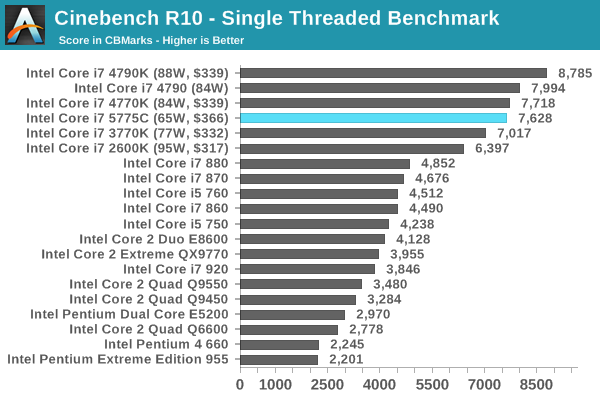
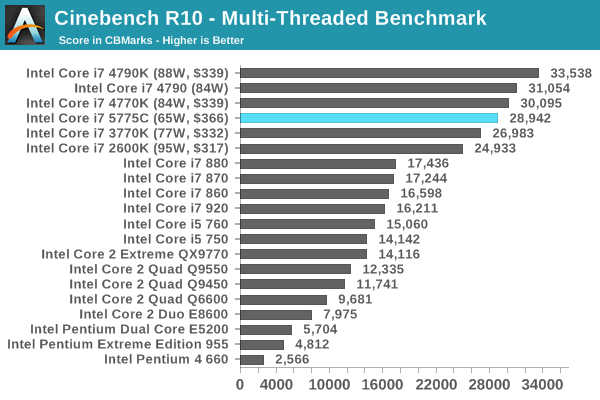


With some of these benchmarks, due to applications using new instruction sets, having the newer processors with the new instructions can make a lot of difference. Even in Cinebench R10, moving from the Core 2 Quad Q9550 to a Broadwell can get a 2.5x speed-up in this old software.
For the rest of our CPU benchmarks, here is what the landscape looks like with the most recent architectures. All of our benchmark results can also be found in our benchmark engine, Bench.
Office Performance
The dynamics of CPU Turbo modes, both Intel and AMD, can cause concern during environments with a variable threaded workload. There is also an added issue of the motherboard remaining consistent, depending on how the motherboard manufacturer wants to add in their own boosting technologies over the ones that Intel would prefer they used. In order to remain consistent, we implement an OS-level unique high performance mode on all the CPUs we test which should override any motherboard manufacturer performance mode.
Dolphin Benchmark: link
Many emulators are often bound by single thread CPU performance, and general reports tended to suggest that Haswell provided a significant boost to emulator performance. This benchmark runs a Wii program that raytraces a complex 3D scene inside the Dolphin Wii emulator. Performance on this benchmark is a good proxy of the speed of Dolphin CPU emulation, which is an intensive single core task using most aspects of a CPU. Results are given in minutes, where the Wii itself scores 17.53 minutes.

WinRAR 5.0.1: link
Our WinRAR test from 2013 is updated to the latest version of WinRAR at the start of 2014. We compress a set of 2867 files across 320 folders totaling 1.52 GB in size – 95% of these files are small typical website files, and the rest (90% of the size) are small 30 second 720p videos.
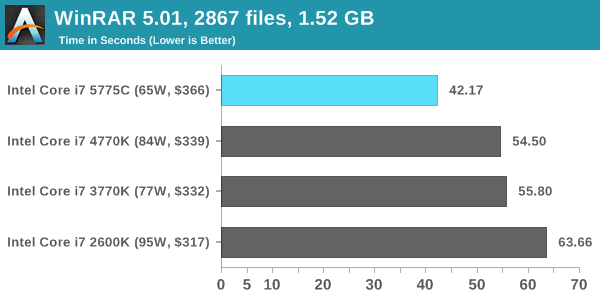
3D Particle Movement
3DPM is a self-penned benchmark, taking basic 3D movement algorithms used in Brownian Motion simulations and testing them for speed. High floating point performance, MHz and IPC wins in the single thread version, whereas the multithread version has to handle the threads and loves more cores.
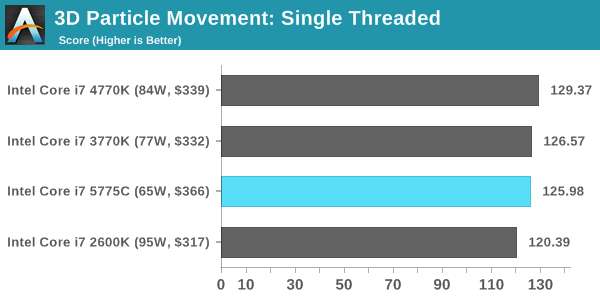
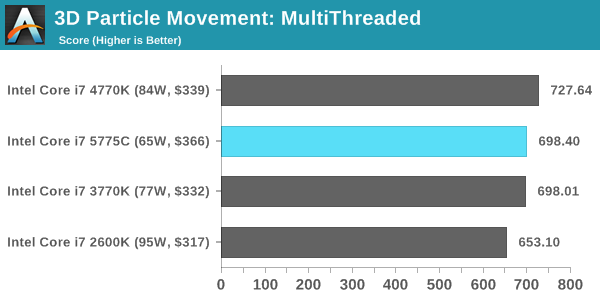
FastStone Image Viewer 4.9
FastStone is the program I use to perform quick or bulk actions on images, such as resizing, adjusting for color and cropping. In our test we take a series of 170 images in various sizes and formats and convert them all into 640x480 .gif files, maintaining the aspect ratio. FastStone does not use multithreading for this test, and results are given in seconds.
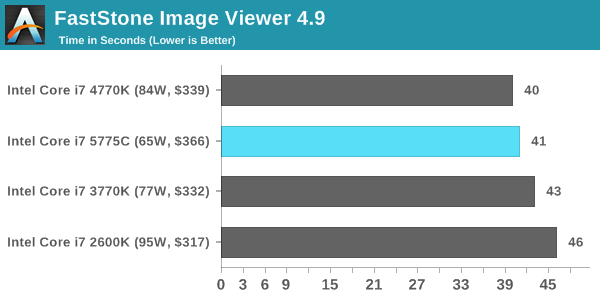
Web Benchmarks
On the lower end processors, general usability is a big factor of experience, especially as we move into the HTML5 era of web browsing. For our web benchmarks, we take four well known tests with Chrome 35 as a consistent browser.
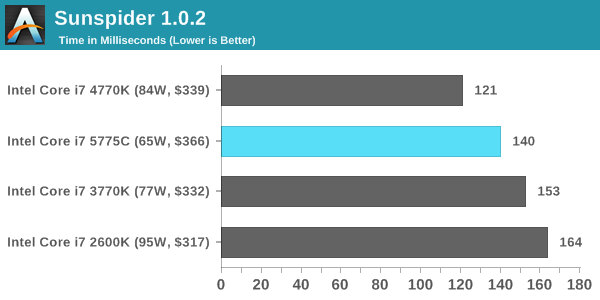
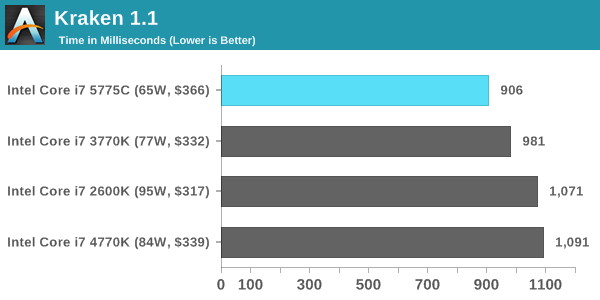
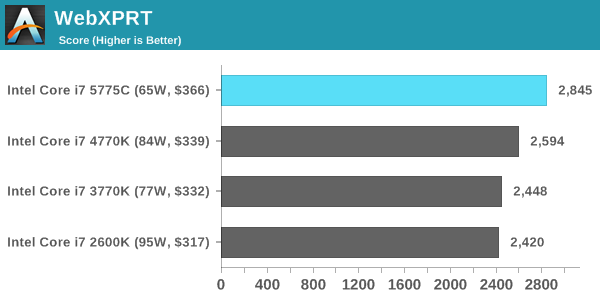
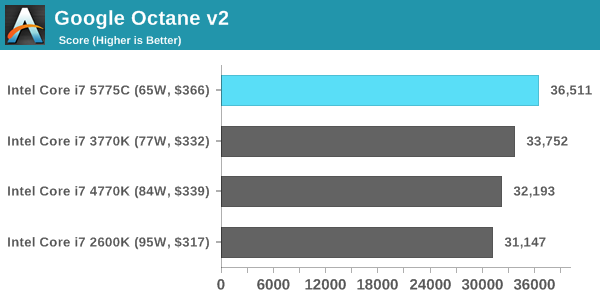










121 Comments
View All Comments
Pissedoffyouth - Monday, August 3, 2015 - link
Can the integrated GPU overclock well? The reason I ask is I have a very micro PC currently with an A10-7800 and I'm looking at getting this badboy to replace itderuberhanyok - Monday, August 3, 2015 - link
you'd have to find one for sale, first.zepi - Monday, August 3, 2015 - link
At least in Europe these are relatively easy to come by in retail.hmind - Wednesday, August 5, 2015 - link
Hey, the answer will more than likely be no, i see no oc tools for igpu overclocking in my pc's z97 bios and my testing on older an intel hd 4600 igpu yeilded no results so i do doubt intel will unlock the igpu, if you can just hold out for the next big apu launch or skylake or get faster ram (which will easily allow the 7800 to catch this chip up if you can get a 2400 mhz kit since kaveri gains a lot from better ram) then you will be sitting pretty, im also sure you can overclock amd igpu's no matter whether or not the cpu is locked so if you haven't already tried it do that.deruberhanyok - Monday, August 3, 2015 - link
Fantastic article! I know more than a few people who will be happy to see there's still no compelling performance reason to upgrade their Sandy Bridge systems. Talk about getting extra bang for the buck!Any chance you might be able to do a quick follow-on post and throw some Nehalem numbers in there? I'm sure there's a few first-gen Core i7 owners wondering if it's worth the upgrade now, or to try and hold off for Skylake.
On a side note, does anyone know when we'll actually be able to buy these Broadwell processors?
Glock24 - Monday, August 3, 2015 - link
Would be nice to have a similar comparison for mobile CPUs, and even more so a comparison of generational improvements of mobile integrated graphics.Marburg U - Monday, August 3, 2015 - link
Still no reason to retire my Q9550@4.8.Marburg U - Monday, August 3, 2015 - link
err: of course it's 3.8.extide - Monday, August 3, 2015 - link
What would you consider worth upgrading for then? I mean a moderately overclocked modern cpu could easily be twice as fast as your setup, not to mention the numerous platform upgrades since...I mean sure, the Q9550 may be fast enough to not be a dog, but there certainly is a lot to be gained...
lukarak - Tuesday, August 4, 2015 - link
But to be gained for what? Back in the day, you had to upgrade, because new content formats were emerging. I distinctly remember buying a PC every two years in the 90's early 00 period. I had a 386, then a 486, then a Pentium 166 (no MMX :), Celeron 333, Athlon 1100, Athlon x64 3200+. The reason I upgraded was the new content. MP3s, DVDs, XviDs, MKVs. All of them weren't able to be played on some of these systems. There was a reason to invest. The i7-920 system I have now for 6.5 years is still going. Sure, there are games, and there is 4k, but 4k is not the jump HD was over DVDs. There just comes a point where you don't notice. Like with smartphones, 150 to 300 ppi, night and day. 300 and 5xx ppi? Not so much. There's just no reason to upgrade if not for numbercrunching or gaming.